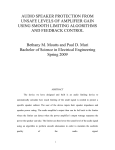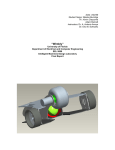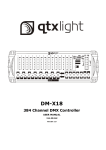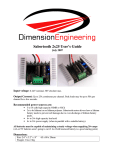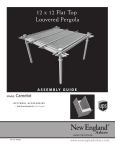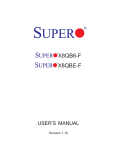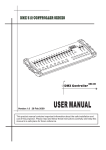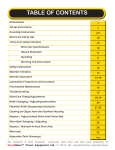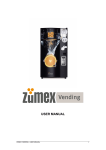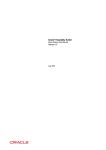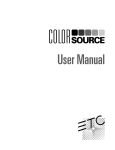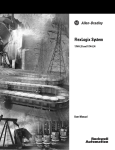Download "user manual"
Transcript
RS232 Serial to HD44780 compatible LCD controller interface USER MANUAL Adapter Version V1A, V1B - Software V1.2.1 Congratulations on your purchase! Before connection or power up please read the quick start guide. Through out this manual the RS232 to HD44780 compatible LCD controller interface is referred to as simply the “Adapter” Page INDEX Index 1 Quick Start Guide 2 Command Summary 3 Expanded Command Summary 4 User Created Characters 9 Settings Retained at Power Down 10 Settings Reset During “Test” mode 10 Hardware Description 11 The Adapter Pin Outs 15 Adapter attached to Datavision 2x16 Display 17 The Adapter and an Emerging Displays SPC 1 94V LCD Display 20 Enlarged Pictorial of the Adapter 22 Revisions, changes 23 -1- RS232 Serial to HD44780 compatible LCD controller interface QUICK START GUIDE Interface board shown component side up. Larger image at rear of this manual. Caution - Please be extremely careful that your power connections are made properly. Reverse power or incorrect power will likely cause immediate failure. Note the location of PIN 1 of the 18 pin connector it is NOT the first pin but rather the third pin as noted in the drawing above. The first two pins are for LED backlight supply. On the three pin input/power connector “GND” is the common for both the +5dvdc supply and the RS232 signal. For those having used adapters such as this in the past much of what you see here should be intuitive. Most RS232 signals from microprocessors will be TTL non-inverted. The enclosed jumper should then be between the center post and the NON INVerted pin shown in the drawing. If connecting to a personal computer most often the signal needs INVerting, the jumper would then be from the INVerting terminal to the center terminal. This is the only jumper required. For testing the jumper can be placed across the TEST pins (shown above). This will cause a reset of parameters within the microprocessor as well as generating a continuous string of repeating characters across the display. TEST continues until the jumper is removed and power is disconnected and restored. There are three User Control Outputs. Pins 1-3 of the 8 pin dual row connector. Pin 8 (bottom left of the connector in the drawing above) is the return path for the Output Pins. Note these are connected directly to the microprocessor and are therefore current limited to a few milliamps. An LED could be controlled directly but not such high current items as relays. For software commands if you have used the P.H. Anderson pic controller you will find the commands used here very similar and in many applications find little modification of your existing software will be needed, removal of time delays being most common. The adapter is shipped in the 4x20 display mode, 9600 baud, 8 bit mode, medium display intensity and heartbeat LED on. Any of these parameters can be easily changed via software commands. Some require a power down - power up to adapt the display to the changes made. The adapter can be used with most known display types from 1x6 to the 4x20. If the addressing remains consistent across the display, the display should function. Displays that will not function are those one or two line displays with split addressing or a non-sequential address on the same row of characters. -2- RS232 Serial to HD44780 compatible LCD controller interface COMMAND SUMMARY COMMANDS ENTER ?a Home Cursor ?Gyxx LCD row(y) and column(xx) configuration Change baud 1=300, 2=1200, 3=2400, 4=9600, ?vmvx 5=19200 (change is immediate) Cursor style x=0 none, =1 blink+underline, =2 blink, ?cx =3 underline. ?f Clear Screen and cursor to row 0 column 0 ?Bxx Set Backlight intensity hex 01 to FF, 01=dark Select screen visible at turn on 0=blank, ?Sx 1=default/config and 2=user defined Define a line of user screen, characters should be equal to row defined in ?Gyxx above, pad with spaces if needed. Columns equal to columns defined in ?Gyxx starting ?Cx with column 0. ?i Move cursor forward ?h Move cursor backward ?j Move cursor to same column one row up ?k Move cursor to same column one row down Move cursor one space left and empty that space. ?b Destructive backspace. ?l Clears current line ?m Cursor to start of current line – carriage return ?n Cursor to start of next line, that line cleared Move cursor to xx position starts with zero and two ?xxx digits are required. ?yx Move cursor to y row, y starts with zero ?sx Set tab at x position, one digit allowed ?t Move to tab position, current line no wrap ?Dx ?R ?Hx ?Lx ?Zx ?Ix ?? Define custom characters, x is character (0-7) Reload custom characters – used after a change Take user output pin to high level x=1,2 or 3 Take user output pin to a low level x=1,2,or 3 Toggles the heartbeat LED on/off x=1= on, all else off Selects LCD Interface x=4= 4bit, all else 8 bit Sends a question mark? to the display Multiple commands are acceptable -3- EXAMPLE “?a” “G420” or “G106” “vmv3” =2400 baud “?c0” = no cursor “?f” “?B80” = medium “?S2” = defined screen “?C0 This is a line “ “?i” “?h” “?j” “?k” “?b” “?l” “?m” “?n” “?x05” “?y1” “?x5” “?t” “?D0000a00110e000000” creates a smiley face “?R” “?H3” “?L3” “?Z1” ?I4” “??” “?y2?x05Hello World?n” RS232 Serial to HD44780 compatible LCD controller interface Expanded Command Summary Note that all commands are case sensitive. As well some commands must have two or more digits to complete the command. An example of this is ?Bxx backlight intensity. A two digit response along with the ?B entry characters is required. If the response desired is 6, for instance, than 06 must be used. Failure to respond correctly will in some cases generate an unwanted response. There is no requirement for wait states or delays with any command. Wait states, if any, are transparent to the end user. ?a Home Cursor This command returns the cursor to row 0, column 0. It does not clear the screen. ?Gyxx LCD row(y) and column(xx) configuration This command sets the size of the display tracked and handled by the microcontroller software. This command requires in addition to the command prompt and G one digit representing the number of rows, up to 4 and two digits representing the number of columns. Parameter is stored in EEPROM so is retained at power off. The default display size is 4x20. If the test mode is entered the adapter will be returned to this 4x20 default. Displays from 1x6 to 4x20 have been tested and found functional. Some displays have non contiguous addressing on one line and will not function correctly. Non contiguous addressing is expected on multi line displays and handled transparently by the microcontroller software. Since display size is a software issue it does not matter the size selected. For instance, if needed, you could set a 4x20 physical size display for say 2x10. The data would then be displayed in a 2x10 window contained within the 4x20 display. Selecting a display size larger than the actual size will cause characters to be invisible as some would be displayed outside the physical viewing area. A common error is to enter this command as ?G2x16. This will cause the display size to be 2 rows 1 column wide. Re-entering the command correctly ?G216 will immediately correct the situation changing the display size to 2 rows by 16 columns wide. ?vmvx Change baud rate x is an integer from 1 to 5 representing the baud rates as follows: 1=300 baud, 2=1200 baud, 3=2400 baud, 4=9600 baud, 5=19200 baud. Parameter is stored in EEPROM so is retained at power off. The changes made are immediate. Your software will have to change its rate as soon as the command is entered or your data will not be displayed properly. At some point you may select and program a rate only to become confused as to what has happened. There are two ways to maneuver out of this situation. The first is to power down, then up the adapter/LCD display. During startup with the normal logo screen the currently selected baud rate is displayed. Failing this another possibility is to power down the adapter/LCD combination and insert a jumper across the test terminals. This will cause the processor software to do an initialization to its stored defaults. This causes the adapter to revert to its default baud rate of 9600. The flexibility of a changeable baud rate was felt to outweigh the disadvantages possibly created by allowing software baud rate changes. -4- RS232 Serial to HD44780 compatible LCD controller interface ?cx Cursor style select. X is a single digit in the range of 0 to 3 enabling the following cursor styles, x=0 none, x=1 blink+underline, x =2 blink, x =3 underline. Parameter is stored in EEPROM so is retained at power off. Changes made are immediate. Blink + Underline causes the current but yet to placed character position to have its eighth row of 5 dots to be blackened and the area where the character will be displayed to flash alternately between black and background color. Blink is the alternating black block without the underline eighth row. And of course underline is just the blackened eighth row without the alternating block. The whole process is easier to see than explain. ?f Clear Screen and cursor to row 0 column 0 This command has no options and is immediate. This command invokes the LCD controllers clear screen function. Although there is about a 1.5ms delay to process this command the delay is normally transparent to the user due to the software buffer size of the microprocessor. ?Bxx Backlight Intensity In addition to the ?B requires two hex digits 0-Fand 0-F. The letters A_F are case sensitive and must be uppercase characters. Dark is 00 and full bright is FF. The default value is 0x80 a midrange setting. Parameter is stored in EEPROM so is retained at power off. Brightness level is controlled via PWM and changes in brightness should be perceptible across the entire scope of adjustment. ?Sx Select Startup Screen Requires in addition to the ?S a single numeric digit in the range of 0-2. Parameter is stored in EEPROM so is retained at power off. This is the screen displayed for a short time on power up. Screen ?S1 display the startup parameters. ?S0 is a blank screen and ?S1 displays a user defined screen. ?Cx Define the line(s) making up the User Defined Startup Screen Requires in addition to the ?C at least a single digit representing the line to be edited 0 to a maximum of 3. The entry needed here will be dependant upon the size of the display you have selected in the ?G command. If you have selected a 1x40 display you will be expected to enter a ?C0 followed by 40 characters of your choice. I.e. bbbbbbbThisb b isb b ab b controllerb b test! bbbbbbbbbbbbbbbbbbbb The bb represent spaces and must be ?C0b included if needed to complete a line. After the last character is entered the display will blank and display the changed user line as well as all others stored in memory (at least that portion which will fit the defined display size). If desired the command can be sent in its entirety command plus data or fragmented in shorter segments. The command could be sent first followed by the data on the next line. ?i Move Cursor Forward one space -5- RS232 Serial to HD44780 compatible LCD controller interface No parameters required. Cursor is shifted one space to the right. There is no effect on existing test. If at the end of a line the cursor will wrap – move to the start of the next line. If at the end of the display the cursor will wrap to the start of the display. ?h Moves Cursor Backward one space No parameters required. Cursor is shifted one space to the left. There is no effect on existing text. If at the beginning of a line the cursor will wrap to the end of the preceding line. If at the beginning of the display the cursor will wrap to the end of the display. ?j Moves Cursor Up one row No parameters are required. Moves cursor up one row remaining in the same column. If at the first row (row 0) the cursor will wrap to the last row of the display. ?k Moves Cursor One Row Down No parameters are required. Moves cursor one row down, remaining in the same column. There is no effect on existing text. If on the last row the cursor will wrap to the first row. ?b Moves Cursor Back One Space No parameters are required. Moves cursor back one space and deletes the entry at that location. A destructive backspace. If at the beginning of a line the cursor will move to the end of the line above and if at the beginning of the display (row 0, column 0) the cursor will wrap to the end of the display. ?l Clear current line No parameters are required. All entries on the cursor line are deleted – replaced with blank spaces. The cursor is returned to the first position of the erased line. ?m Cursor returned to the Start of the Current Line No parameters are required. The cursor is moved to the first space of the line it is on. There is no effect on any displayed text. This would be considered a carriage return without a line feed. ?n Cursor returned to the Start of the Next Line No parameters are required. The cursor is moved to the start of the next line and that line is cleared. There is no effect on text in the current cursor line. The next line is cleared. If you are using a one line display, however, the cursor is returned to the first position and that line is cleared. If the cursor is on the last line of the display it will wrap and clear the first line of the display. This would be considered a carriage return with a line feed. ?xxx Position Cursor to Column xx Two parameters are required. The cursor will be moved to the location specified by xx on the same row it is currently on. If the values entered would place the cursor beyond the end of the line the command is ignored. Two digits are required. If you wished to move the cursor to position 5 of the current line the command would be ?x05 Remember that the rows first position is 0. So the preceding command would put the cursor at the displays physical location of 6. This command can be used to move the cursor either -6- RS232 Serial to HD44780 compatible LCD controller interface forward or backward as long as the command would cause the cursor to stay on the current line. ?yx Moves Cursor to Designated Row. One Parameter is required. This must be a single digit. The cursor will be moved to the row equaling x. If the row does not exist the command will be ignored. On a four line display the command ?y3 will put the cursor on the fourth row of the display. Remember rows start with 0 ?sx Sets Tab at x Position One parameter is required and must be in the range 1-9. This command sets the tab amount used by the command ?t. If the tab is outside of the display range the command is ignored. There is no wrap with this command so all settings are applied to the current cursor row. ?t Moves Cursor to Tab Position No parameters are required. This command moves the cursor to the position defined in the command ?sx. There is no wrap with this command so tab movement applies to the current line. If the command would require the cursor to be moved outside the current display area the command is ignored. ?Dx Defines Custom Characters Requires one parameter and a total of eight data bytes consisting of two hex digits each. The HD44780 controller has a 64 byte area which is modifiable by the user. This area for our purposes is used for the generation of custom characters. Please refer to the page “Custom Character Creation” for a more in depth explanation of how this is accomplished. This area is preloaded with 8 custom characters which can be seen during the test mode (first characters sent) or by asking your software to display characters 0 through 7. The characters you create are stored in EEPROM so are not affected by shutting off the Adapter/LCD combination. ?R Reloads Custom Characters No parameters are required. After changes are made in the custom characters the changes are stored in EEPROM but not in the volatile LCD memory. This command loads the LCD HD44780 controller with the values contained in the Adapters EEPROM area. ?Hx Sets User Output High One parameter is required in the range of 1-3. There are three user outputs Pins 1,2 and 3 of the eight pin connector. These are set in a HIGH or turned on state by this command followed by the output you want affected. If you wish to turn on Output Pin 1 send ?H1, pin one will then go into a HIGH state. Please remember these pins are connected directly to the microcontroller and therefore cannot be expected to deliver more than a few milliamps of current. Also be cognizant of damage that might be caused by attaching a circuit that would produce a voltage that the microprocessor cannot handle i.e. more than -7- RS232 Serial to HD44780 compatible LCD controller interface 5V or some negative voltage or perhaps AC of some sort. Pin eight of the eight pin connector is the GND or return path for these outputs. ?Lx Sets User Outputs Low One parameter is required in the range of 1-3. This is the logical opposite of the ?Hx command. ?L1 sets user output PIN 1 to a logical low, or to its off state. Again all the same cautions apply. These pins can only sink a few milliamps. ?Zx Toggles the Heartbeat LED One parameter is required either a 1 or anything else. The command ?Z1 turns the LED Heartbeat on. Any other digit or text used will cause the LED Heartbeat to be turned off. This value is retained in EEPROM and so will only need to be entered once. The Heartbeat LED exists on the upper right corner of the component side of the Adapter. The LED changes state at about 1 second intervals when the Adapter is powered. The LED is useful during troubleshooting when you have no LCD output and are wondering if the Adapter is functioning. The LED is buffered so is not loading any output more than a few microamperes. ?Ix Toggles the LCD Interface Mode One parameter is required either a 4 or anything else. The command ?I4 turns on the four bit data line interface mode. All other entries after the ?I will turn the four bit data line interface off and the eight bit data line interface on. This use of four bit data line interface or eight bit data line interface is a hardware decision which creates a software need. Most HD44780 and compatibles will run in either mode. Some displays just have a four bit data line interface mode as it is less complex. Other compatibles are wired as eight bit data line interface and seem to function better as eight bit. We feel the decision as to four or eight bit should be left to you the user and so allow both, with your control. The interface mode is saved and so remains through power down or restart. The interface mode is displayed on line 0 of the default startup screen. If the Adapter is placed in test mode the interface will be returned to a default of eight bit interface mode. The Adapter will change modes immediately, the LCD will require a power down – power up to change the data line interface mode. ?? Send a Question Mark to the display The parameter is the question mark. Since we are using the ? mark as our command signal we need a way for you to utilize the question mark if needed. Just send two in a row to display one question mark. -8- RS232 Serial to HD44780 compatible LCD controller interface Custom Character Creation In the discussion that follows it is assumed that you have had some exposure to the HEXadecimal and Binary numbering systems. Custom characters are stored in EEPROM and loaded on power up of the Adapter / LCD combination. After power up custom characters can be reloaded with the ?R command. A character is represented on the LCD in a 5x7 matrix. There are actually 8 rows but the bottom row is reserved for the cursor. There are also the three initial columns which are imaginary and not part of the display but are used in the calculation of the digits required to turn on the display elements. Byte 1 2 3 4 5 6 7 8 0 0 0 0 0 0 0 0 0 0 0 0 0 0 0 0 0 0 0 0 0 0 0 0 x x x 0 x x x x 0 0 0 0 Binary 0b00000000 0b00001010 0b00000000 0b00010001 0b00001110 0b00000000 0b00000000 0b00000000 Hex 0x00 0x0a 0x00 0x11 0x0e 0x00 0x00 0x00 In this example we desire to create a smiley face. The heavy line grid represents our actual 5x7 pixel character display area. In this area we have put an x in the pixels we wish to display as black. Now it is a simple matter to generate a binary table from each row. For instance row 2 or byte 2 would start with the three mandatory zeros, then from our pixel plot the next 5 pixels going horizontally are off, on, off, on, and off or expressed in binary 01010 we add the three preceding blank spaces and get binary 00001010 converted to hex is 0a. This hex digit is what the Adapter expects when programming your custom characters. The command for creating our smiley face would be D0000a00110e000000. D is the command, the next digit tells the software we are working on the first of the eight possible characters (numbering starts with zero) then the next 16 alphanumerics are the hex numbers from top to bottom in the above chart. Really pretty easy once you work through a few characters. It is easiest to use a table like the one above so here is blank table for your own use. Byte 1 2 3 4 5 6 7 8 0 0 0 0 0 0 0 0 0 0 0 0 0 0 0 0 0 0 0 0 0 0 0 0 0 0 0 0 0 Binary 0b000 0b000 0b000 0b000 0b000 0b000 0b000 0b00000000 -9- Hex 0x 0x 0x 0x 0x 0x 0x 0x00 RS232 Serial to HD44780 compatible LCD controller interface Settings Retained at Power Down Some parameters are retained in a non-volatile memory storage area of the microprocessor or its EEPROM. These are: Baud Rate Display Size Data Interface lines to HD44780 (4 or 8) Initial Screen type to be displayed Cursor style LED Backlight Brightness level User created custom characters User created custom screen Once selected these values should remain as set until changed by user interaction. During power up these parameters are loaded from EEPROM. Also during power up all custom characters (0-7) are loaded into the HD44780. Settings reset during “TEST” mode Some values are reset to a default mode during the TEST sequence. These are: Baud Rate Display Size Interface (data) lines to HD44780 (4 or 8) Initial Screen to be displayed Cursor style LED Backlight Brightness level Reset to 9600 Baud Reset to 4x20 Reset to 8 bit Reset to settings display/mfg screen Reset to flashing with underline cursor on Reset to midrange (hex 80, 0x80) - 10 - RS232 Serial to HD44780 compatible LCD controller interface Hardware Please refer to the Adapter pictorial locate at the end of the Users Manual during the following discussion. During hardware design versatility for the end user was of primary concern. The circuit was designed for an easy connecting of a standard .1”spacing power/data input connector. Easily switchable input signal conditioning between inverting and non inverting inputs. An user selectable onboard heartbeat LED. An easily entered parameter restoring test mode. Crystal controlled microprocessor clock for very accurate baud rates. Finally attention was given to the varied and different connection methods the Adapter would have with manufactured LCD displays. Of all the different attachment methods, one of the first to consider is whether to make the mounting to the back of the LCD semipermanent or temporary. By attaching a female socket connector to the Adapter and a set of male header pins to the LCD display, the adapter can be unplugged and tried with various LCD displays. The connectors used in this method, though, allow the adapter to sit fairly high above the LCD and might make this method less desirable. The cleanest method is just to solder a single male header to both the Adapter and the LCD. This allows the adapter to sit so close to the LCD that all one needs is a small square of double sided tape to hold the Adapter securely in place. Ultimately the choice is yours. The Adapter is supplied with one snapable 16 pin male header. If desired the 16 pin male header can be separated into two seven pin connectors to allow direct connect to a 14 pin LCD. Note also there are TWO versions of the 14 pin dual inline connector. One version starts from pin one and counts down the row of 7 pins then back up the other row of seven pins ending with pin 14 across from the pin1. This is the numbering scheme used on integrated circuits. Version 1A uses this scheme. The other version, which is probably more common, has staggered counting. Pin two is across from pin 1, pin 3 is below pin 1 and so the first row is numbered 1,3,5,7,9,11,13 and the second row is numbered 2,4,6,8,10,12,14. Version 1 of the board uses this scheme. While on the subject of connecting to an LCD some important information needs you attention. Many displays use a standard 14 pin inline connection. All signals required for display of data are conveyed through these pins in eight bit interface mode. This is relatively standardized. (1.) GND (2.) V+ (3.) Vcon (4.) RS (5.) R/!W (6.) E (7.) DB0 (8.) DB1 (9.) DB2 (10.) DB3 (11.) DB4 (12.) DB5 (13.) DB6 (14.) DB7 - 11 - RS232 Serial to HD44780 compatible LCD controller interface There are two more pins used sometimes at the end of the 14 signal pins, sometimes at the beginning of the 14 signal pins and sometimes completely separate from the 14 signal pins. These are used for the LED backlight. Most common is a 16 pin connection with pins 15 (V+) and 16 (V-) delivering power to the LED backlight. However some displays have moved these pins 15 and 16 to a place in front of the 14 row of signal pins. The adapter is designed to work with both. However in giving this versatility the connecter on the adapter is slightly more complex. If working with an LCD display with the LCD backlight power connections place at the front of the 14 pin signal pins the Adapter is a direct connection to the LCD. This shown in the image below (fig 1). The LCD display is a Datavision 16244-68 2x16 display with a yellow-green LED backlight. Two more images follow one of the Datavsion LCD (fig 2) by itself and another showing a closeup of the pins connection (fig 3) and their numbering scheme. Figure 1 - The adapter is slightly elevated to make the connector pins more obvious (Version 1 Adapter) - 12 - RS232 Serial to HD44780 compatible LCD controller interface Figure 2 – The Datavision 16244-68 2x16 LCD module. Figure 3 - The Datavision 16244-68 2x16 LCD module. Closeup of the connecting pins. Note the pins 16 and 15 precede the pin 1. The Adapter is a direct connect for this module If the display has the more common 14 pin connection with the LED backlight at the end of the 14 pins, then the Adapter is shifted LEFT two positions relative to the LCD connections. This is shown in the attached image (fig 4). - 13 - RS232 Serial to HD44780 compatible LCD controller interface Figure 4 – The more normal connection with the LED backlight being driven by pins 15 and 16 at the end of the row of 14 signal pins. (Version 1 Adapter) Please refer to you display datasheet and the pin out of the Adapter to make sure you are connecting your display properly. Irreversible damage can be done to the Adapter, The LCD or both if improperly connected. The Adapter is not designed to handle the high voltage of an electroluminescent display (EL display). Please do not attached the LED outputs to EL display inputs. The requirements for an electroluminescent display are quite different. - 14 - RS232 Serial to HD44780 compatible LCD controller interface Adapter Connector Pin Outs 18 Pin LCD Interface connector – single row connector Position Pin Number Description 1 16 LCD Bklt Gnd (Square PCB Land) 2 15 LCD Bklt +5 3 1 Vss Gnd supply return 4 2 Vcc +5 Supply 5 3 Contrast control 6 4 RS 7 5 R/W 8 6 E 9 7 DB0 10 8 DB1 11 9 DB2 12 10 DB3 13 11 DB4 14 12 DB5 15 13 DB6 16 14 DB7 17 15 LCD Bklt +5 18 16 LCD Bklt Gnd Note: Both pins 15 are the same electrically, and both pins 16 are the same electrically. 14 Pin LCD Interface connector – two row of 7, 14 pin connector Pin Number Description 1 Vss Gnd supply return (Square PCB Land) 2 Vcc +5 Supply 3 Contrast control 4 RS 5 R/W 6 E 7 DB0 (Used in 8 bit mode only) 8 DB1 (Used in 8 bit mode only) 9 DB2 (Used in 8 bit mode only) 10 DB3 (Used in 8 bit mode only) 11 DB4 12 DB5 13 DB6 14 DB7 - 15 - RS232 Serial to HD44780 compatible LCD controller interface 8 Pin User Output Pin Number 1 2 3 4 5 6 7 8 Description User Output #1 (Square PCB Land) User Output #2 User Output #3 DB0 (Future use – do not connect) DB1 (Future use – do not connect) DB2 (Future use – do not connect) Pin 31 ATMega (Test, not user accessible) Gnd (Common for User Outputs 1,2,3) 3 Pin Signal Pin Number 1 2 3 Description Non Inverting (Square PCB Land) Common Inverting 2 Pin Test Pin Number 1 2 Description Test (Square PCB Land) Common 3 Pin Input Pin Number 1 2 3 Description Signal +5VDC Supply Common for Supply and RS232 Signal - 16 - RS232 Serial to HD44780 compatible LCD controller interface Permanent attachment of the Adapter to the Datavison 2x16 Display The Adapter in action, here a project is monitoring the temperature and voltage of a motor. Notice on the left the incoming 5vdc power and single signal wire. (The protective film, still on in this photograph, diffuses the display) On the reverse side the adapter is dwarfed by even a 2x16 display. Notice the dual row 14 pin header, test connector and 8 pin user header have not been installed since they were not needed for this project. Also note this display connector is shifted left or the first two pins are for the LED backlight. (Version 1A Adapter) - 17 - RS232 Serial to HD44780 compatible LCD controller interface The Adapter can be made to sit very close to the display board. In this application the board is separated from the Adapter with a layer of double sided 1/8” thick tape. Once soldered the package is very rigid. (Version 1A Adapter) One more angled picture to show the close clearance between boards. (Version 1A Adapter) - 18 - RS232 Serial to HD44780 compatible LCD controller interface Top down view of the Adapter mounted to a 2x16 LCD Display. Notice how close the tabs of the LCD retainer are to the board. The two tabs under the Adapter were bent over to prevent their touching the Adapter. (Version 1A Adapter) - 19 - RS232 Serial to HD44780 compatible LCD controller interface The ADAPTER and an Emerging Displays SPC 1 94V LCD Display Here is an image of a Rev 1B Adapter attached to a 14 pin dual inline Emerging Display SPC 1 94V. Note the red and black wires for the backlight LED of the display. These are “plugged” into socket pins 14 (+) and 15 (-) of the Adapter. In this oblique view notice that this adapter has both an 18 pin inline female header socket and a dual row 14 pin female header socket attached. This gives the user a lot of flexibility in the interchange of LCD displays. - 20 - RS232 Serial to HD44780 compatible LCD controller interface Finally here is the end view of the Adapter and the Emerging Displays unit. The adapter was raised slightly to make the connection more obvious. The user can “fill” the area between the adapter and the LCD display with a few squares of layered double sided foam tape to make the installation more permanent. - 21 - RS232 Serial to HD44780 compatible LCD controller interface Enlarged Pictorial of the Adapter - 22 - RS232 Serial to HD44780 compatible LCD controller interface REVISIONS and CHANGES May 19, 2008 V1.1 Software Realized the third character of the baud rate change command (%) was also a C format specifier. Changed the character string expected to vmv instead of the UD% sign. May 25, 2008 V1.2 Software Screen delay times are now tied to the input character buffer, If the buffer is empty upon entry to a screen delay (i.e. startup screens, baud rate change etc) the delay will be full length. If the buffer has received or is receiving data then the delays are bypassed thus giving the received data priority. June 5, 2008 V1A Hardware Asthetically more pleasing functionally almost identical to Version 1. V1A PC Boards have a tighter component placement which helps to reduce a possible overhang when used with some LCD ‘s. 14 Pin LCD header is now inline with first pin of 16 Pin header.The 14 pin LCD header is wired the same as integrated circuits. (Down across and then back up). One more additional very slight circuit modification which does not affect user operation but allows us to test the finished Adapters more easily. Board is now solder masked both sides and silk screened on component side. Overall board size reduced from 2.09” x 1.25” (5.3 x 3.18cm) to 1.85” x 1.25” ( 4.7 x 3.18cm). 11.5% reduction in area. Pictorials denote the Version 1 or Version 1A Adapter board. July 1, 2008 V1B Hardware Physically, the same size (1.85” x 1.25”) and appearance as the V1A Adapter. Electrically the V1B’s primary difference is the treatment of the 14 pin dual row connector. This version has pin 2 across from pin 1 and ends with pin 14 on the bottom of the two row connector. Functionally the same as V1A. July 4, 2008 V1.2.1 Software Slight change in software needed for a very intermittent full bright backlight flash in 8 bit data mode only. 4 bit data mode was unaffected. - 23 -























